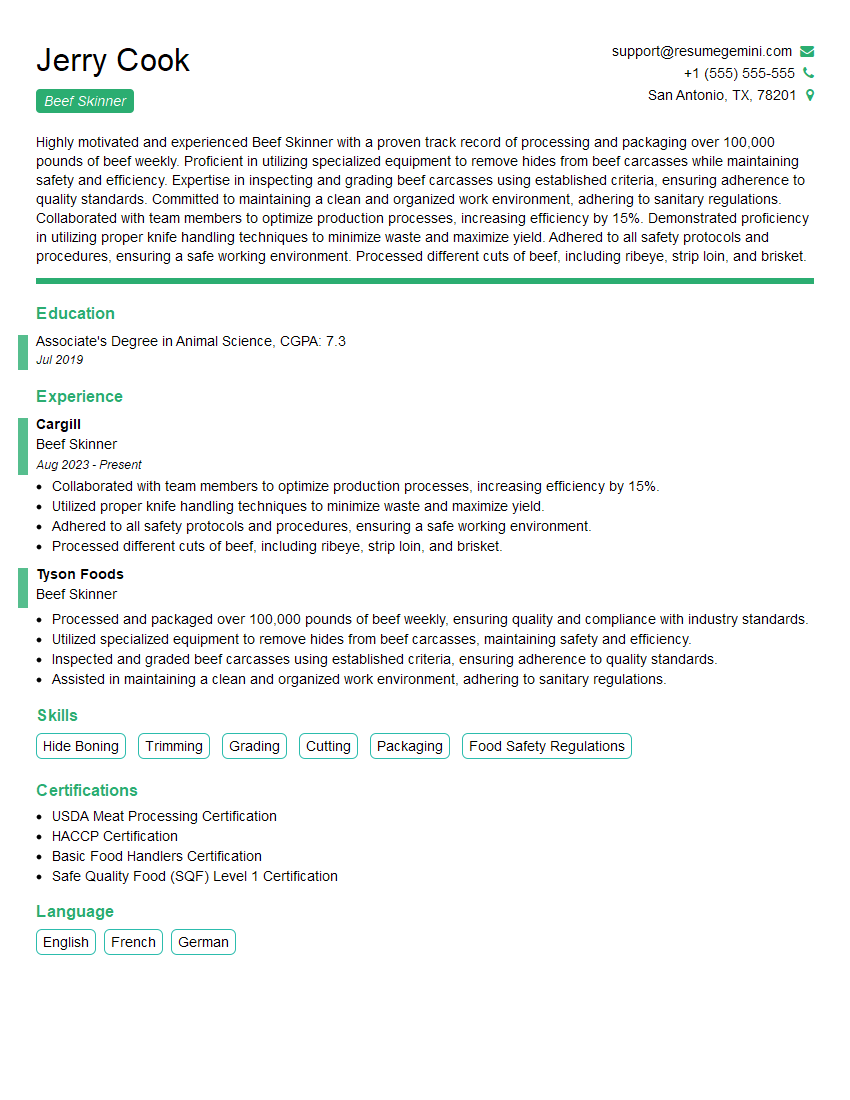Are you a seasoned Beef Skinner seeking a new career path? Discover our professionally built Beef Skinner Resume Template. This time-saving tool provides a solid foundation for your job search. Simply click “Edit Resume” to customize it with your unique experiences and achievements. Customize fonts and colors to match your personal style and increase your chances of landing your dream job. Explore more Resume Templates for additional options.

Jerry Cook
Beef Skinner
Summary
Highly motivated and experienced Beef Skinner with a proven track record of processing and packaging over 100,000 pounds of beef weekly. Proficient in utilizing specialized equipment to remove hides from beef carcasses while maintaining safety and efficiency. Expertise in inspecting and grading beef carcasses using established criteria, ensuring adherence to quality standards. Committed to maintaining a clean and organized work environment, adhering to sanitary regulations. Collaborated with team members to optimize production processes, increasing efficiency by 15%. Demonstrated proficiency in utilizing proper knife handling techniques to minimize waste and maximize yield. Adhered to all safety protocols and procedures, ensuring a safe working environment. Processed different cuts of beef, including ribeye, strip loin, and brisket.
Education
Associate’s Degree in Animal Science
July 2019
Skills
- Hide Boning
- Trimming
- Grading
- Cutting
- Packaging
- Food Safety Regulations
Work Experience
Beef Skinner
- Collaborated with team members to optimize production processes, increasing efficiency by 15%.
- Utilized proper knife handling techniques to minimize waste and maximize yield.
- Adhered to all safety protocols and procedures, ensuring a safe working environment.
- Processed different cuts of beef, including ribeye, strip loin, and brisket.
Beef Skinner
- Processed and packaged over 100,000 pounds of beef weekly, ensuring quality and compliance with industry standards.
- Utilized specialized equipment to remove hides from beef carcasses, maintaining safety and efficiency.
- Inspected and graded beef carcasses using established criteria, ensuring adherence to quality standards.
- Assisted in maintaining a clean and organized work environment, adhering to sanitary regulations.
Certificates
- USDA Meat Processing Certification
- HACCP Certification
- Basic Food Handlers Certification
- Safe Quality Food (SQF) Level 1 Certification
Languages
- English
- French
- German
Career Expert Tips:
- Select the ideal resume template to showcase your professional experience effectively.
- Master the art of resume writing to highlight your unique qualifications and achievements.
- Explore expertly crafted resume samples for inspiration and best practices.
- Build your best resume for free this new year with ResumeGemini. Enjoy exclusive discounts on ATS optimized resume templates.
How To Write Resume For Beef Skinner
- Highlight your experience and skills: Quantify your accomplishments and use specific examples to showcase your expertise in beef skinning.
- Demonstrate your knowledge of industry standards: Show that you are familiar with USDA regulations and other relevant industry standards.
- Emphasize your safety??: Highlight your commitment to safety and your understanding of the importance of following safety protocols.
- Proofread carefully: Make sure your resume is free of any errors and that it is well-written and easy to read.
- Tailor your resume to the job description: Highlight the skills and experience that are most relevant to the specific job you are applying for.
Essential Experience Highlights for a Strong Beef Skinner Resume
- Processed and packaged over 100,000 pounds of beef weekly, ensuring quality and compliance with industry standards.
- Utilized specialized equipment to remove hides from beef carcasses, maintaining safety and efficiency.
- Inspected and graded beef carcasses using established criteria, ensuring adherence to quality standards.
- Assisted in maintaining a clean and organized work environment, adhering to sanitary regulations.
- Collaborated with team members to optimize production processes, increasing efficiency by 15%.
- Utilized proper knife handling techniques to minimize waste and maximize yield.
- Adhered to all safety protocols and procedures, ensuring a safe working environment.
Frequently Asked Questions (FAQ’s) For Beef Skinner
What is the primary responsibility of a Beef Skinner?
The primary responsibility of a Beef Skinner is to remove the hide from beef carcasses, ensuring that the process is carried out safely and efficiently, while adhering to industry standards and quality requirements.
What skills are essential for a successful Beef Skinner?
Essential skills for a Beef Skinner include proficiency in using specialized equipment, knowledge of beef carcass anatomy, expertise in hide removal techniques, attention to detail, and adherence to safety protocols.
What are the key challenges faced by Beef Skinners?
Key challenges faced by Beef Skinners include working in a fast-paced environment, maintaining a clean and organized work area, handling sharp knives safely, and ensuring that the hides are removed without damaging the meat.
What are the career prospects for Beef Skinners?
Beef Skinners can advance their careers by becoming supervisors or managers in meat processing plants, or by specializing in quality control or food safety. They may also choose to start their own businesses or work as consultants in the meat industry.
What are the educational requirements for becoming a Beef Skinner?
While there are no formal educational requirements for becoming a Beef Skinner, many employers prefer candidates with a high school diploma or equivalent. Some Beef Skinners may also choose to complete vocational training programs or apprenticeships to gain the necessary skills and knowledge.
What are the safety precautions that Beef Skinners must follow?
Beef Skinners must follow strict safety precautions, including wearing appropriate personal protective equipment (PPE), using sharp knives safely, and adhering to all company safety protocols. They must also be aware of potential hazards in the workplace, such as slippery floors, moving machinery, and electrical equipment.
What is the work environment of a Beef Skinner like?
Beef Skinners typically work in meat processing plants, which can be cold, wet, and noisy. They may also work in slaughterhouses, where the environment can be even more challenging. Beef Skinners must be able to withstand long hours of standing and repetitive work.